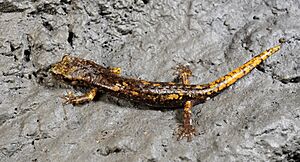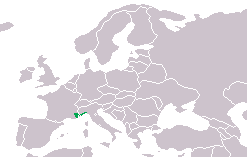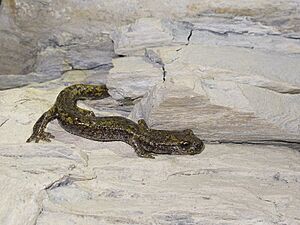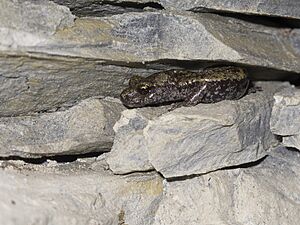French cave salamander facts for kids
Quick facts for kids French cave salamander |
|
|---|---|
 |
|
| Conservation status | |
| Scientific classification | |
| Genus: |
Speleomantes
|
| Species: |
strinatii
|
 |
|
The French cave salamander (Speleomantes strinatii) is a small salamander. It grows to about 10 to 12.5 centimeters long. You can find it in northwest Italy and southeast France. It looks a lot like the Italian cave salamander. But the French cave salamander has a lighter belly.
Contents
About the French Cave Salamander
The French cave salamander lives entirely on land. It is one of seven types of salamanders called "plethodontids" found in southern Europe.
These salamanders can be different sizes. Males are usually about 9.6 centimeters long. They can grow up to 11.6 centimeters. Females are a bit larger, averaging about 10 centimeters. They can reach up to 12.3 centimeters.
The French cave salamander has an oval-shaped head. Its snout is rounded. It also has a slight overbite, which is more noticeable in males. Its back legs are a little longer than its front legs. The back feet have five toes, while the front feet only have four.
These salamanders come in many different colors and patterns. They are often brown and black. But some have spots, blotches, or striped patterns. These patterns can be red, yellow, gray, green, or even look metallic.
Where They Live
French cave salamanders live in the southeast part of France. They also live in northwest Italy. Their home range stretches from the Alpes de Haute Provence area to northwest Tuscany. This includes the Maritime Alps, Ligurian Alps, and Ligurian Apennines mountains.
You can often find them from sea level up to 2,290 meters high. In the Maritime Alps, they have even been seen at 2,432 meters.
These salamanders do not always live in caves. For example, when it gets very hot, they go into cooler underground places. This makes them more comfortable.
They can be active all year long. They like places that are humid, like the caves they are named after. You can find them in caves, cracks, and other hidden spots from late spring to summer.
Protecting the French Cave Salamander
The French cave salamander was last checked for The IUCN Red List of Threatened Species in 2021. This list said that S. strinatii is an endangered species. This means their numbers are going down.
Many things are causing this decline. These include new buildings and businesses. Climate change and bad weather also play a part. Logging, tourist areas, and city growth destroy their homes. Climate change is a big threat because these salamanders need very specific weather conditions to survive.
How They Behave
Territory and Movement
When they are in caves, French cave salamanders do not move very much. Young salamanders tend to stay closer to the cave entrances. Older salamanders live deeper inside the caves.
Adult salamanders have been seen traveling 3 to 49 meters away from their caves. Young ones do not go as far. They only explore between 1 and 12 meters from their cave homes. When conditions are good, they can move about 10 meters per day on the forest floor.
Males and females seem to be equally good at finding their way back home.
What They Eat
French cave salamanders are not picky eaters. They hunt for many different kinds of invertebrates. These are animals without backbones, like insects. They tend to eat more in the autumn.
Reproduction and Life Cycle
How They Have Babies
Not much is known about how French cave salamanders reproduce in the wild. They have a mating season, and most pregnant females are found in the fall.
When kept in captivity, these salamanders hide their eggs among loose rocks and fallen leaves. Their eggs are ivory white. They are about 5 to 6 millimeters wide. After 8 months, the eggs will become twice as big.
How Long They Live
When they hatch, young salamanders are about 2.2 to 2.4 centimeters long. Male French cave salamanders can start having babies when they are three years old. Females become ready to reproduce at four years old.
Observations in captivity show they might live about six years. However, one salamander was found again after more than 17 years. This suggests they can live much longer in the wild.
Parental Care
Some amphibians, like frogs, are known to care for their young after they hatch. But not much has been reported about this in salamanders. We do not know much about their nests or egg clutches in the wild. However, in captivity, females have been seen laying between six and fourteen eggs.
Egg Guarding
Female salamanders have been seen guarding their eggs for up to ten months. While guarding, the females would coil around their eggs. They would defend them against other salamanders that came too close. Sometimes, the mother would even eat her own eggs.
In one study, scientists watched a female S. strinatii guarding her eggs. She laid her eggs in small dips on the ground. For the first week, the mother was always touching her eggs. She often rotated them with her back legs. After ten days, she started leaving her nest for short times, from 3 to 46 minutes.
Another female salamander tried to get into the nest. The mother chased her away. She also bravely defended her eggs from rats. During the time she was guarding, the female stayed with her eggs 98% of the time.
By the time the eggs started hatching, only two of the nine eggs were left. The first egg hatched after 45 weeks. The second egg hatched five days later. Because of this gap, the two babies were different sizes. The first one was bigger.
For the first week after hatching, the mother stayed very still in the nest. She was motionless about 97% of the time. This decreased by 20% by the sixth week. The baby salamanders often touched their mother's skin. The mother was also seen carrying her babies on her back many times.
In the sixth week, the babies started leaving the nest by themselves for the first time. Forty-two days after hatching, all three salamanders left the terrarium for good.
Threats from Germs
Like other Hydromantes salamanders, the French cave salamander produces a special liquid from its skin. This liquid helps protect them. Their bright patterns might also warn predators that they are not tasty.
Two types of single-celled fungi, Batrachochytrium salamandrivorans and Batrachochytrium dendrobatidis, have harmed amphibian populations worldwide. These fungi cause a disease called chytridiomycosis. This disease can destroy the amphibian's skin. It also messes up their salt and water balance, leading to heart failure.
Batrachochytrium dendrobatidis affects frogs, salamanders, and caecilians. Batrachochytrium salamandrivorans only affects newts and salamanders. These fungi likely came from Asia and spread through the pet trade.
While Batrachochytrium salamandrivorans has not been found in France or Italy yet, it is close by. Scientists think it might spread there soon. However, the French cave salamander's skin liquid might protect it. This liquid has been shown to kill the fungus within 24 hours. Because of this, scientists believe this fungus might not harm French cave salamander populations as much as it has other amphibians.




